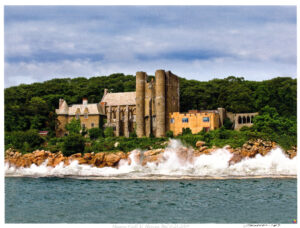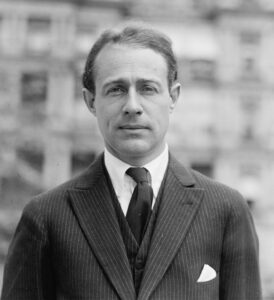By David Wilkening, Contributing Writer

Photo/Carin MacNamara
GLOUCESTER – Yearn to visit a castle? Go to Europe. Or stay in the United States. California has the famous Hearst Castle in San Simeon. Or closer to home, try Gloucester, where you’ll find the Hammond Castle Museum.
Europe has more castles than anywhere in the world; an estimated 25,000. The exact number is not known, but the European Castle Institute is working on it. Germany is Europe’s “king” with the greatest number. The United States has only a few dozen. The Hearst and the Hammond in Gloucester, however, are invariably ranked among this country’s top ten.
Hearst-Hammond connection
The builders of both were contemporaries. William Randolph Hearst (1863-1951) and John Hays Hammond knew each other. Hammond died in 1936 at the age of 81 in an easy chair in his showplace at Gloucester. “I wouldn’t characterize the relationship between Hammond and Hearst as extremely close, but they were certainly friendly associates,” said John Leysath, curatorial director of the Hammond Castle Museum.
Hearst is best known as a failed politician and successful newspaper publisher. He was also the subject of the famous film “Citizen Kane,” often regarded as the greatest movie of all time, where his collection at “Xanadu” was his museum.
An unsung hero

Hammond was not as well known, but he was also a highly successful inventor credited with hundreds of patents and best known for his development of radio remote control that was the basis for modern missile guidance systems. He is sometimes called an “unsung hero of our modern technology.”
There were other connections between both the two and their fathers.
Both men’s castles are well known for their diverse collections. Both Hammond and Hearst were “avid collectors, almost to the level of being packrats, and their tastes were similarly eclectic,” Leysath said. Hearst was wealthier than Hammond. His castle reflects more grandiose and often more valuable artifacts.
“Both spring from the same trend of wealthy individuals building castles modeled on historical buildings; both projects overlapped in terms of time of construction. And both incorporate pieces of ancient and medieval buildings in their structure,” Leyseth explained.
A big tourist attraction
Hammond Castle Museum draws about 35,000 visitors a year and attendance is again picking up this year. “I’m not sure we have a breakdown of what percentage of age groups visit the castle,” said Leysath.” I will say in my experience, we do have everything from children to older folks, but it seems the older folks are more engaged in the history of the museum.”
Visitors to the Hammond Castle are immediately impressed with its location high on a cliff overlooking the Atlantic ocean at 80 Hesperus Ave. The castle served as his home and laboratory. It houses Hammond’s unique collection of inventions as well as Roman, medieval and Renaissance art. Hammond also designed a gigantic pipe organ as the centerpiece for his Great Hall, which has been played by some of the greatest organists in the world. Meanwhile, the building itself has a dungeon, an armory and even a secret passageway out of one of the many bedrooms.
Everything expected in a castle
Hammond’s creation contains all the things you would expect in a medieval castle: a massive drawbridge when beginning a tour, flying buttresses and of course, gargoyles.
Many visitors are often impressed with the 2nd century Roman child’s sarcophagus in the courtyard. It was likely never used for a burial. Also impressive: the collection of over 50 headstones dating from the late Roman to late medieval periods. “And of course, Hammond’s own massive pipe organ of his own design, one of the largest in the Western hemisphere,” Leysath said. It is currently unplayable but there are plans to restore it.
Visitors learn that he was the son of John Hays Hammond Sr., who became wealthy as a mining engineer in Cecil Rhodes’ mines in South Africa. He grew up in South Africa and then in England where he became fascinated with castles. His fame relies on his inventions and patents. Claiming mentors of both Thomas Edison and Alexander Graham Bell, he registered more than 800 foreign and domestic patents on more than 400 inventions, generally in the fields of radio control and naval weaponry.
The Boston, Massachusetts architectural firm of Allen & Collens was hired in 1923 to design Hammond’s dream residence. Today, there are guided and self-guided tours. But visitors should know the castle is not handicap accessible. Also, there’s no air conditioning and there are many steps with narrow spiral staircases.
RELATED CONTENT:
The road ended where it began for ‘The father of the Beats’ (fiftyplusadvocate.com)
Essex and Ipswich remain havens for antiques lovers (fiftyplusadvocate.com)
Rockport’s ‘Paper House’ has endured for a century (fiftyplusadvocate.com)












